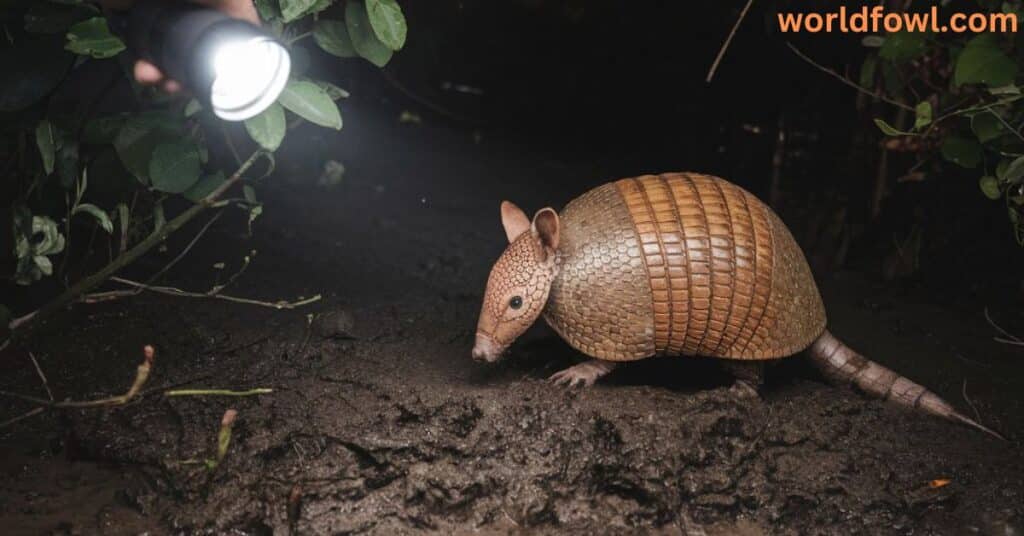Armadillos are often misunderstood creatures. Their tough, armor-like shells and nocturnal habits might make them seem like dangerous animals, but in reality, they are generally shy, solitary creatures. Still, the question remains: Do armadillos attack humans? It’s not uncommon to wonder if these animals, with their distinctive protective shell and sharp claws, could pose a threat to humans. While armadillos aren’t naturally aggressive toward humans, there are a few factors that could lead to a surprising interaction. In this deep dive, we’ll explore armadillo behavior, the conditions under which they might attack, the potential risks they pose, and how you can safely coexist with these fascinating creatures.
What Are Armadillos?

Before we get into the details of whether armadillos attack humans, it’s important to understand the basic nature of these creatures. Armadillos belong to the order Cingulata, which is made up of armored mammals. They are known for their distinctive hard shells, which serve as their main defense mechanism against predators.
Physical Features of Armadillos
Armadillos are typically medium-sized creatures, with the nine-banded armadillo being the most common species found in the United States. These creatures have a distinct appearance, with a tough, leathery outer shell made of bony plates that provide them with protection. The shell covers the back, sides, and head, while the underbelly remains soft.
Their sharp claws are used for digging, which they do with remarkable speed and efficiency. Armadillos primarily use their claws to dig for food, such as ants, termites, and other small insects. This burrowing behavior is a significant part of their lifestyle and can sometimes cause issues when they dig under buildings, fences, or gardens.
Armadillos have poor vision, relying primarily on their sense of smell to locate food. They are nocturnal, meaning they are most active during the night when they go out in search of food. Due to their nocturnal habits, armadillos tend to avoid human interaction during the day, making encounters with them relatively rare.
Armadillo Habitats
Armadillos are found in a wide range of habitats across the Americas, from the southern United States to South America. They thrive in warm, arid climates and are often found in forests, grasslands, and deserts. The Texas wildlife area is home to a large population of armadillos, and these creatures are often encountered in suburban areas or rural farms where they can dig and forage in peace.
Armadillos are highly adaptable creatures, able to live in a variety of environments as long as they have access to food and places to burrow. These creatures dig burrows that serve as both shelter and a place to store food, and they can dig up to 15 feet in length. While they are not aggressive by nature, their digging behavior can sometimes lead them into conflict with humans, especially when their burrows cause damage to gardens, lawns, or even the foundations of buildings.
See Also : Do Anteaters Attack Humans? A Closer Look!
Do Armadillos Attack Humans?

The short answer to this question is: no, armadillos do not typically attack humans. Armadillos are not naturally aggressive creatures. In fact, they are far more likely to avoid human contact than to seek it out. Their primary instinct is to protect themselves by fleeing or burrowing into the ground, rather than engaging in any form of aggression.
However, while armadillos attacking humans is extremely rare, there are situations where an armadillo may exhibit defensive behavior. In these cases, an armadillo’s natural instinct to protect itself may lead to an unexpected interaction. Understanding armadillo behavior is key to preventing such encounters and ensuring that both humans and armadillos stay safe.
Armadillo Defensive Behavior
An armadillo’s first line of defense is its protective shell. This shell is designed to shield the animal from predators, and it is highly effective in keeping larger animals, such as coyotes or wild dogs, at bay. However, when confronted with a perceived threat, armadillos have several defensive behaviors to rely on.
- Burrowing: When threatened, armadillos will typically dig into the ground and retreat into their burrows. This is their most common response when they feel threatened, as it allows them to escape danger quickly.
- Running Away: If they can’t burrow, armadillos will often attempt to run away. Although their mobility on land is somewhat limited due to their heavy armor, they can still move at a reasonable pace when fleeing from danger.
- Jumping: Armadillos are also known for their ability to leap straight into the air. This behavior is often triggered by sudden movements or loud noises, but it’s not an aggressive act. Instead, it’s a defense mechanism to escape perceived threats. If you encounter an armadillo, it’s best to remain calm and avoid startling it, as this might trigger an unexpected jump.
Despite these defensive behaviors, it’s extremely rare for an armadillo to become aggressive toward a human. Most of the time, if an armadillo feels threatened, it will either burrow or run away.
See Also : Do Ostriches Attack Humans? The Shocking Truth!
Understanding Armadillo Behavior

To understand why armadillos do not typically attack humans, we need to look at their behavior in more detail. Armadillos are solitary, nocturnal creatures that primarily focus on finding food and shelter. Their behavior is driven by survival instincts rather than any form of aggression.
Nocturnal Habits
Armadillos are nocturnal, meaning they are most active at night. During the day, they rest in their burrows, avoiding the heat of the sun and seeking shelter from potential predators. At night, armadillos emerge from their burrows to forage for food. This makes them less likely to encounter humans, as they are typically active when people are indoors or asleep.
However, wildlife encounters can still happen, especially in suburban areas where armadillos may venture into gardens or yards in search of food. These encounters are usually brief, and the armadillo will typically try to flee when it senses a human presence.
Burrowing Behavior
Burrowing is a key part of armadillo behavior. Armadillos use their sharp claws to dig tunnels that serve as both shelter and a place to store food. These burrows can sometimes cause damage to lawns, gardens, and even the foundations of buildings. This can lead to conflict with humans, but it is not an indication of aggression. Instead, it’s a natural behavior that is driven by the armadillo’s instinct to create a safe environment for itself.
In most cases, armadillos are simply looking for a place to live and feed. They do not target specific areas or humans intentionally. However, when they burrow in residential yards or gardens, their presence can sometimes be seen as a nuisance. Homeowners might mistake this behavior for aggression, but it’s really just the armadillo’s way of going about its day-to-day life.
See Also : Can Geese Attack Humans? Geese Gone Wild
Circumstances That May Lead to Aggression
While armadillos are generally non-aggressive, there are certain circumstances in which they may react defensively. If an armadillo feels threatened or cornered, it may exhibit aggressive behavior. However, such incidents are extremely rare.
Feeling Cornered or Trapped
Armadillos are not confrontational creatures by nature. They prefer to avoid conflict, but if they feel trapped or cornered, they may become more defensive. This can happen if an armadillo is caught in an area where it has no escape route. In such situations, the armadillo might bite, scratch, or try to defend itself in other ways.
Injury or Illness
An injured or sick armadillo may be more likely to act aggressively than a healthy one. Pain and discomfort can cause the armadillo to lash out as a defense mechanism. If you encounter an armadillo that seems to be acting erratically or aggressively, it’s possible that the animal is in distress.
Protecting Offspring
While armadillos are generally solitary, females with young may display more protective behavior. In this case, they may see humans or other animals as threats to their offspring and react defensively. However, this is still a rare occurrence, as armadillos typically do not engage in aggressive behavior even when they have young.
See Also : Do Praying Mantis Attack Humans? Praying Mantis vs. Humans!
Are Armadillo Attacks Dangerous?

Though armadillos are generally harmless, it’s still important to understand the potential risks associated with an armadillo encounter. The main concern with armadillos is not physical injury from an attack, but the potential for disease transmission.
Leprosy Transmission
One of the more significant health risks associated with armadillos is their potential to carry leprosy, a bacterial infection caused by Mycobacterium leprae. Armadillos, particularly in the southern United States, have been found to be leprosy carriers, and there have been documented cases of humans contracting the disease through direct contact with armadillos or their habitat.
Leprosy is a slow-developing disease that affects the skin, nerves, and mucous membranes. It can cause permanent damage to the skin, nerves, and limbs if left untreated. However, leprosy transmission from armadillos to humans is extremely rare. The disease is typically transmitted through prolonged exposure to armadillos, particularly when handling them or coming into contact with their feces or burrows.
If you live in an area where armadillos are common, it’s important to take basic disease precautions. Avoid handling armadillos or disturbing their burrows, and wear gloves if you must work in areas where armadillos are active. If you suspect that you’ve been exposed to an armadillo’s habitat, make sure to wash your hands thoroughly and disinfect any tools or clothing.
See Also : Do Cicadas Attack Humans? Myths vs. Facts
How to Avoid Armadillo Encounters

While armadillo attacks on humans are exceedingly rare, it’s still a good idea to take precautions to avoid unwanted interactions with these animals. Here are some tips for minimizing the chances of an armadillo encounter:
Preventing Armadillos from Entering Your Yard
Armadillos are known to be attracted to gardens and lawns where they can dig for food. If you want to keep armadillos out of your yard, consider the following:
- Fencing: Install sturdy fences around your property to prevent armadillos from burrowing into your yard. Ensure that the fence extends several inches into the ground to prevent digging underneath.
- Remove food sources: Armadillos are attracted to grubs, insects, and other small creatures that live in the soil. Treating your lawn for pests can help make it less appealing to armadillos.
- Fill in burrows: If you find that an armadillo has dug a burrow in your yard, fill it in as soon as possible to discourage further digging.
Safe Practices Around Armadillo Habitats
If you live in an area where armadillos are common, there are several steps you can take to stay safe:
- Avoid touching armadillos: While armadillos are not aggressive, it’s always best to avoid handling them. They are wild animals, and contact with them can lead to the transmission of diseases like leprosy.
- Give them space: If you encounter an armadillo, give it plenty of space to escape. Armadillos are naturally shy and will usually flee if given the chance.
- Don’t startle them: Sudden movements or loud noises can cause an armadillo to react defensively. Stay calm and give the animal room to move away.
FAQs
Can Armadillos Carry Diseases?
Yes, armadillos can carry diseases, most notably leprosy (Mycobacterium leprae). While leprosy transmission from armadillos to humans is rare, it is still a potential risk, particularly if you handle an armadillo or come into contact with its feces or burrows. It’s important to take proper disease precautions and avoid direct contact with armadillos in areas where they are known to carry this disease. Wearing gloves and thoroughly washing your hands after any contact with armadillo habitats can reduce your risk of exposure.
What Should I Do If I See an Armadillo?
If you encounter an armadillo, the best course of action is to remain calm and avoid startling it. Armadillos are naturally shy creatures that prefer to avoid humans. Simply step back and give the animal space to escape. If the armadillo seems injured or disoriented, it may be best to contact a wildlife rehabilitation center or animal control for assistance. Avoid touching the animal to reduce the risk of disease transmission, and never attempt to capture or handle it yourself.
Are Armadillos Aggressive Toward Pets?
Armadillos are generally not aggressive toward pets. However, they may react defensively if they feel threatened. Most interactions with pets, such as dogs, occur when pets investigate armadillos or their burrows. In rare cases, if an armadillo feels cornered or threatened, it may scratch or bite in an attempt to protect itself. Pet owners should keep dogs on leashes and monitor them closely in areas where armadillos are active. Preventing wildlife encounters with pets can reduce the risk of injury or disease transmission.
Can Armadillos Bite?
While armadillos have sharp claws and teeth, they are not typically inclined to bite humans. Armadillos are more likely to use their defensive behavior, such as burrowing or running away, to escape from perceived threats. Bites are rare and usually occur only if the armadillo feels trapped or cornered. In general, armadillos are not aggressive toward humans and will avoid conflict whenever possible. However, to stay safe, it’s important to avoid handling armadillos or disturbing their burrows to prevent any unexpected reactions.
Conclusion: Do Armadillos Attack Humans?
In conclusion, armadillos do not attack humans in the traditional sense. These fascinating creatures are generally non-aggressive and prefer to avoid human interaction altogether. Their defensive behavior involves burrowing, running away, or jumping to escape danger, rather than attacking. However, disease risks like leprosy transmission do pose a concern in rare cases, making it important to handle armadillo encounters with care.
By understanding armadillo behavior, taking precautions to avoid close contact, and securing your property from their burrowing habits, you can safely coexist with these unique creatures. Remember, the likelihood of an armadillo attacking a human is extremely low, but respect for their space and the environment they inhabit will ensure that you can appreciate their presence without fear.

Henry James is a seasoned blogger and a passionate storyteller on “World Fowl.” With years of experience crafting engaging content, he brings a unique blend of expertise and creativity to his writing. Henry specializes in exploring diverse topics with depth and clarity, captivating readers worldwide.


